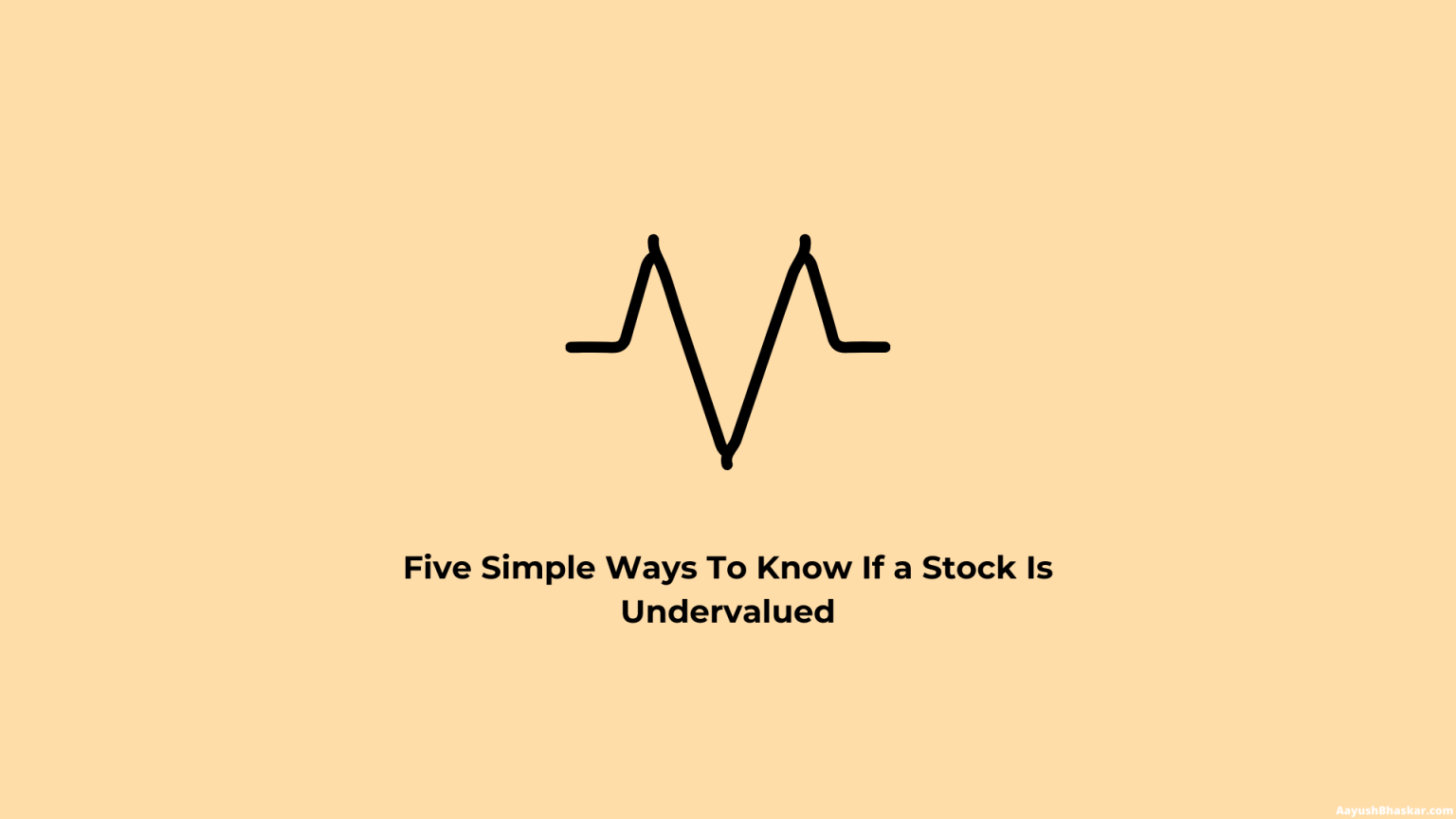Are you an investor interested in finding stocks to invest in? Can’t decide if the stock is overvalued or undervalued and want to know whether you should start buying now or later? A simple valuation ratio could be your answer.
Instead of taking advice from someone just because they happen to be famous, you should instead focus on trying to determine whether a stock is undervalued or not by yourself. You might be wondering if this is even possible. The answer is yes!
To understand this concept, let’s first figure out what undervalued stocks are, and what are the main factors that contribute to a stock becoming undervalued.
What is an undervalued stock?
An undervalued stock is one that you believe should be worth more than it currently is. If the market agrees with you, then it will climb. The more undervalued a stock is, the more of a profit you can make. But the less certain you are that it’s undervalued.
An undervalued stock trades at less than its intrinsic value. Intrinsic value is, roughly speaking, a company’s liquidation value plus its expected future earnings as discounted by an appropriate interest rate. Warren Buffett describes intrinsic value as the present value of all future distributions to shareholders.
A stock can be mispriced for many reasons, some of which are temporary and some of which aren’t.
Let’s see what causes stocks to become undervalued.
Main Reason For Stock To Become Undervalued
Stocks get undervalued for a variety of reasons. Here are a few examples of how a stock might become undervalued:
- Market crash
When the stock market booms, it often busts soon after. This is referred to as a bubble. When investors become too optimistic about the high share prices, they begin selling their holdings at a rapid pace. This selling is called panic selling, and it causes market prices to plummet.
Do you remember the dot-com bubble?
Buying shares, when this happens, provide you with an opportunity to purchase stocks at a lower price.
- Negative coverage
Excessive negative news reporting of a relatively short-term issue leads a stock to plummet.
For example, suppose a company gets sued by someone who claims its product made them sick. The fact that there’s a lawsuit pending causes the stock to drop from Rs 200 to Rs 100. The shareholders lose half their money.
But if the company wins the lawsuit, the stock goes back to Rs 200 or even more.
- Less confidence
A stock might be undervalued because not enough people know about it, or because they’ve misunderstood what they do know. Most startups are initially undervalued because not enough people know about them. It’s only after they’ve become successful that the price catches up with the value.
- Strong competitors
Strong competitors (or disruptive new market entrants) cause investors to believe the firm is in peril.
For example, suppose there is an industry with only two companies in it: A and B. Company A has twice as much revenue as company B, but company B has twice as much profit per Rupee of revenue.
Which one will sell for more?
It depends on how people value profits vs revenues. Both are indicators
- Downgrades by analysts
When an analyst downgrades a stock, the stock usually goes down. This is especially true if the downgrade comes before a quarterly earnings release. An analyst lowers their price target and rating on a stock because they expect the company to miss earnings estimates.
They’re too focused on the short term, not taking into account the company’s long-term potential or growth prospects.
Sometimes, a company will come out with good earnings but still be downgraded because they didn’t beat expectations. It often works out well for contrarian investors to buy into quality businesses when these companies are undervalued.
These are just a few examples of frequent circumstances that might cause a stock to fall in value.
Let’s move on to ways of identifying an undervalued stock.
Five ways to find undervalued stocks
1. Earnings
The value of any company can be determined by looking at its earnings.
This is why earnings season spurs so much volatility for companies, as investors attempt to buy the highest quality stocks at attractive prices. If a company has been growing earnings at 15% annually over the last 5 years, and it’s now trading for 20 times earnings, it may be undervalued when compared to its historical growth rate.
On the other hand, if earnings have been declining and the stock is still trading at 20 times earnings, it’s probably overvalued. I would recommend you check the P/E ratio of the company.
P/E Ratio: The price-to-earnings (P/E) ratio is one of the most commonly used ratios in investing because it’s easy to calculate. It shows how much investors are willing to spend on a stock relative to its earnings per share (EPS).
To calculate the P/E ratio, divide the price per share by the EPS. Earnings per share are the company’s net profit divided by the total number of shares.
P/E Ratio = Price per Share / Earnings per Share
Keep in mind that P/E ratios might vary depending on the industry. Even though one industry’s P/E ratio is larger than another, the stock may still be undervalued.
The P/E ratio of a company depends on the industry and the stage of development of the company. For example, highly innovative companies like technology firms typically have high P/Es as they invest heavily in research and development; as these companies mature, their P/Es come down.
2. Dividends
Another way to value stocks is through dividends. A dividend indicates that a company has enough cash flow to pay out some of its profits to investors regularly. Companies that pay regular dividends are often more mature and stable than those that don’t and can be less risky investments.
Dividend yield measures how much income you get for each dollar invested in a stock. It is calculated by dividing annual dividends by the price per share and expressing them as a percentage. The larger a dividend yield, the more money you will earn.
Dividend Yield = Annual Dividends Per Share / Market Value Per Share
That’s why high-dividend stocks are often considered “value” stocks. They’re typically mature, stable companies that produce consistent cash flows over time.
Dividends also allow you to earn as you wait for your inexpensive companies to become overpriced. You should choose the company that pays regular dividends.
3. Price to Book Value Ratio
Price-to-book (P/B) is an investment valuation ratio that compares a company’s net asset value to its market capitalization. Sometimes, this metric is also known as the “market-to-book” ratio. P/B can be used to compare companies with one another, or within a single company over time.
The P/B ratio is calculated by dividing the current stock price by its book value per share.
P/B Ratio = Market Price per share / Book Value per share
You can find the book value per share on the balance sheet. It is based on the assets and liabilities of the firm.
If the P/B ratio is lower than 1, then it means that you could buy all the assets of this company for less money than what their market cap is saying it’s worth. In other words, you are getting a discount for buying this company’s assets and business.
If a stock’s price-to-book ratio is greater than 1, it means you’re paying more than what the company is worth.
The P/B ratio is not well suited to growth stocks. It’s better suited to value stocks, which often have no earnings or small losses, but which may still be interesting investments.
4. Debt to Equity Ratio
Debt to equity ratio is used to measure the financial leverage of a company. It is calculated by dividing long-term debt by shareholders’ equity. The higher the ratio, the more leveraged a company is.
D/E Ratio = Total Debts / Total Equity
You can check whether the stock is undervalued or not by checking its debt-to-equity ratio and comparing it with the industry average debt-to-equity ratio. The reason I like comparing my company with others in its industry is that every industry has different “norms” when it comes to borrowing money. There are also different tax benefits depending on what type of business you have.
It is one of the most important numbers to look at while valuing a company. If you have Rs 1 Crore in profits and Rs 2 Crore in debt, that’s not good, even though you have Rs 1 Crore in profits.
The reason many investors want to look at this number is that they would like to buy companies that will be able to pay off their debt. So, when you invest in a company, you’re going to make sure that the company has enough money coming in, so it can service its debt.
5. Return on Equity
Return on equity, or ROE, measures how effectively management deploys investor capital. This is how you calculate it:
ROE = Net income / Shareholder equity
A company is usually undervalued if its return on equity is higher than its growth rate. If you’re a value investor, the easiest way to judge whether the market is undervalued or not is to check the average return on equity of the market. If it’s higher than the long-term growth rate, then it’s undervalued.
If you look at data from 2000 to now, the average return on equity for Indian stocks has been about 14%. You can also see that this number fluctuates over time – sometimes it’s higher and sometimes lower. Whenever it gets lower than 10%, the market gets into trouble in the short term. In 2001, 2008, and 2020, when this number fell below 10%, we had a bear market shortly after that.
Final Words
The market is extremely hard to be a successful investor. The most important thing to realize is that many factors determine the worth of a company.
This is why, before buying a stock, it is incredibly important to have done your research thoroughly and have a strong portfolio that allows you to hold on to stocks even when they are dropping in value. Read Stock Market Research Tools in India to fundamentally analyze any stock in Indian Markets.
I hope you enjoyed the above article, and wish you good luck in the stock market.








Leave a Reply